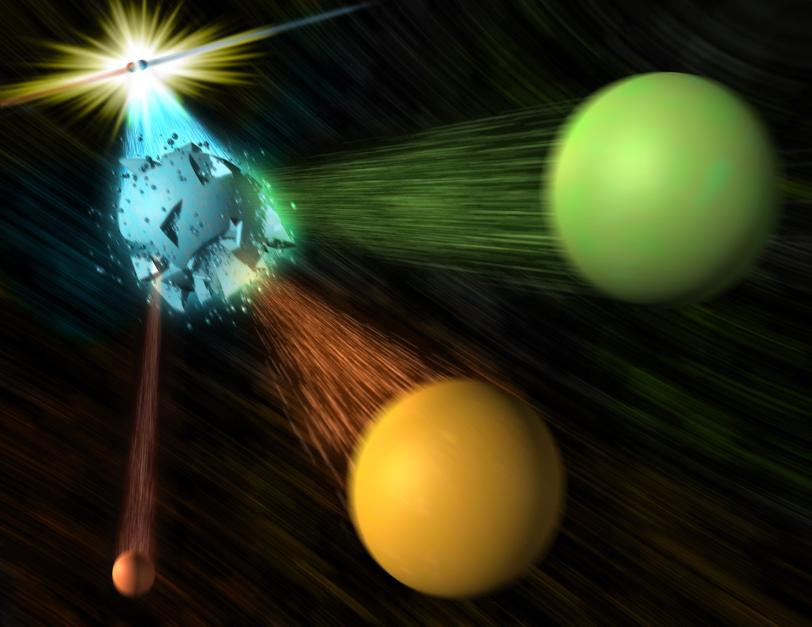BaBar Data Hint at Cracks in the Standard Model
Menlo Park, Calif. — Recently analyzed data from the BaBar experiment may suggest possible flaws in the Standard Model of particle physics, the reigning description of how the universe works on subatomic scales.
Menlo Park, Calif. — Recently analyzed data from the BaBar experiment may suggest possible flaws in the Standard Model of particle physics, the reigning description of how the universe works on subatomic scales. The data from BaBar, a high-energy physics experiment based at the U.S. Department of Energy’s (DOE) SLAC National Accelerator Laboratory, show that a particular type of particle decay called “B to D-star-tau-nu” happens more often than the Standard Model says it should.
In this type of decay, a particle called the B-bar meson decays into a D meson, an antineutrino and a tau lepton. While the level of certainty of the excess (3.4 sigma in statistical language) is not enough to claim a break from the Standard Model, the results are a potential sign of something amiss and are likely to impact existing theories, including those attempting to deduce the properties of Higgs bosons.
“The excess over the Standard Model prediction is exciting,” said BaBar spokesperson Michael Roney, professor at the University of Victoria in Canada. The results are significantly more sensitive than previously published studies of these decays, said Roney. “But before we can claim an actual discovery, other experiments have to replicate it and rule out the possibility this isn’t just an unlikely statistical fluctuation.”
The BaBar experiment, which collected particle collision data from 1999 to 2008, was designed to explore various mysteries of particle physics, including why the universe contains matter, but no antimatter. The collaboration’s data helped confirm a matter-antimatter theory for which two researchers won the 2008 Nobel Prize in Physics.
Researchers continue to apply BaBar data to a variety of questions in particle physics. The data, for instance, has raised more questions about Higgs bosons, which arise from the mechanism thought to give fundamental particles their mass. Higgs bosons are predicted to interact more strongly with heavier particles – such as the B mesons, D mesons and tau leptons in the BaBar study – than with lighter ones, but the Higgs posited by the Standard Model can't be involved in this decay.
“If the excess decays shown are confirmed, it will be exciting to figure out what is causing it," said BaBar physics coordinator Abner Soffer, associate professor at Tel Aviv University. Other theories involving new physics are waiting in the wings, but the BaBar results already rule out one important model called the "Two Higgs Doublet Model."
"We hope our results will stimulate theoretical discussion about just what the data are telling us about new physics,” added Soffer.
The researchers also hope their colleagues in the Belle collaboration, which studies the same types of particle collisions, see something similar, said Roney. "If they do, the combined significance could be compelling enough to suggest how we can finally move beyond the Standard Model.”
The results have been presented at the 10th annual Flavor Physics and Charge-Parity Violation Conference in Hefei, China, and submitted for publication in the journal Physical Review Letters. The paper is available on arXiv in preprint form.
This work is supported by DOE and NSF (USA), STFC (United Kingdom), NSERC (Canada), CEA and CNRS-IN2P3 (France), BMBF and DFG (Germany), INFN (Italy), FOM (The Netherlands), NFR (Norway), MES (Russia), and MICIIN (Spain), as well as support from Israel and India. Individuals have received funding from the Marie Curie EIF (European Union) and the A.P. Sloan Foundation (USA).

About SLAC
SLAC National Accelerator Laboratory explores how the universe works at the biggest, smallest and fastest scales and invents powerful tools used by researchers around the globe. As world leaders in ultrafast science and bold explorers of the physics of the universe, we forge new ground in understanding our origins and building a healthier and more sustainable future. Our discovery and innovation help develop new materials and chemical processes and open unprecedented views of the cosmos and life’s most delicate machinery. Building on more than 60 years of visionary research, we help shape the future by advancing areas such as quantum technology, scientific computing and the development of next-generation accelerators.
SLAC is operated by Stanford University for the U.S. Department of Energy’s Office of Science. The Office of Science is the single largest supporter of basic research in the physical sciences in the United States and is working to address some of the most pressing challenges of our time.